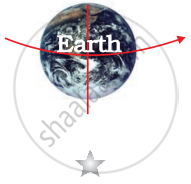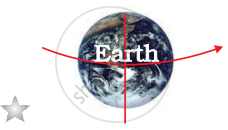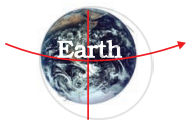Advertisements
Chapters
2: Microorganisms : Friend and Foe
3: Synthetic Fibres and Plastics
4: Materials : Metals and Non-Metals
5: Coal and Petroleum
6: Combustion and Flame
7: Conservation of Plants and Animals
8: Cell—Structure and Functions
9: Reproduction in Animals
10: Reaching the Age of Adolescence
11: Force
12: Friction
13: Sound
14: Chemical Effects of Electric Current
15: Some Natural Phenomena
16: Light
▶ 17: Stars and Solar System
18: Pollution of Air and Water
![NCERT Exemplar solutions for Science [English] Class 8 chapter 17 - Stars and Solar System NCERT Exemplar solutions for Science [English] Class 8 chapter 17 - Stars and Solar System - Shaalaa.com](/images/science-english-class-8_6:5f2b1b2038084cf381bfa42c826a928c.jpg)
Advertisements
Solutions for Chapter 17: Stars and Solar System
Below listed, you can find solutions for Chapter 17 of CBSE NCERT Exemplar for Science [English] Class 8.
NCERT Exemplar solutions for Science [English] Class 8 17 Stars and Solar System Multiple Choice Questions [Pages 97 - 98]
Morning star is the name given to
Pole star
star Sirius
planet Jupiter
planet Venus
Which of the following figures depicts the position of Pole star correctly?
The sun appears to move from east to west around the earth. This means that earth rotates from
East to West
West to East
North to South
West to North
An astronaut standing on the surface of the moon throws a ball upwards. The ball would
directly fall down from the point it is released
hang in space
go up and then, come back to the surface of the moon
keep going up never to come back
Suppose a new planet is discovered between Uranus and Neptune. Its time period would be
less than that of Neptune
more than that of Neptune
equal to that of Neptune or Uranus
less than that of Uranus
The change in seasons on the earth occurs because
the distance between the earth and the sun is not constant
the axis of rotation of the earth is parallel to the plane of its orbit
the axis of rotation of the earth is perpendicular to the plane of its orbit
the axis of rotation of the earth is tilted with respect to the plane of its orbit
The first of a month is the new moon day. On fifteenth day of the same month, which of the following figures would represent the phase of the moon?
NCERT Exemplar solutions for Science [English] Class 8 17 Stars and Solar System Very Short Answer Questions [Pages 99 - 100]
Do stars emit light only during night?
Paheli and Boojho observe a bright object in the night sky which was not twinkling. Paheli says, it is a star and Boojho says it is a planet. Who is correct?
State whether the following is 'True' or 'False'.
The planet nearest to us is Jupiter.
True
False
State whether the following is 'True' or 'False'.
All the stars are at the same distance from us.
True
False
State whether the following is 'True' or 'False'.
The planets do not emit light of their own.
True
False
State whether the following is 'True' or 'False'.
The planets keep changing their position with respect to stars.
True
False
State whether the following is 'True' or 'False'.
The planet Venus appears in the eastern sky before sunrise.
True
False
State whether the following is 'True' or 'False'.
The plane in which the earth revolves around the Sun is called equatorial plane of earth.
True
False
John saw full moon on a particular day. After how many days, he will be able to see the full moon again?
In the picture of rotating earth given as figure mark the position of Pole star.
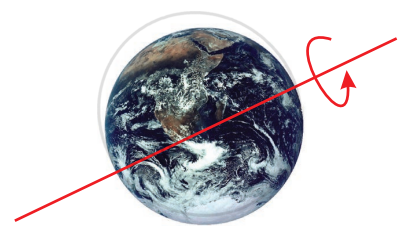
In the given figure, out of the positions A, B, C and D which will indicate the position of the sun? Draw the sun at the appropriate position.
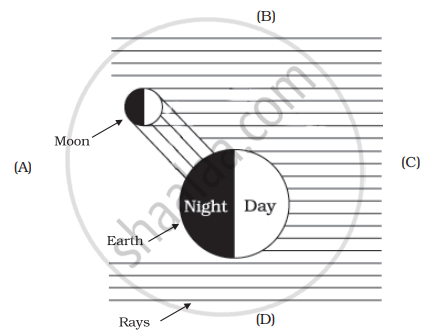
In figure mark the arrows (←),(→),(↓), or (↑) to show the direction of Sunlight.

NCERT Exemplar solutions for Science [English] Class 8 17 Stars and Solar System Short Answer Questions [Page 101]
A star is 10 light years away from the earth. Suppose it brightens up suddenly today. After how much time shall we see this change?
Meteors are not visible during the daytime. Explain the reason.
Why does the moon change its shape daily?
Paheli saw the moon through a glass window at 8:00 pm. She marked the position of the moon on the glass pane. She got up at 4 am in the morning. Will the moon be visible at the same position?
NCERT Exemplar solutions for Science [English] Class 8 17 Stars and Solar System Long Answer Questions [Pages 101 - 103]
Suppose the moon emits light of its own. Would it still have phases? Justify your answer.
Figure shows comets without their tail. Show the tails of the comets at positions A, B, and C. In which position will the tail be longest?
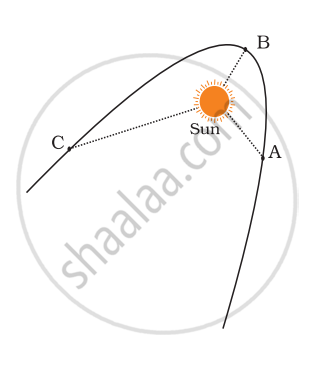
Explain why we always see the same side of the moon.
Look at the figure carefully and answer the following questions :

- In which part of the sky would you see the full moon in the evening?
- In which part of the sky would you see the crescent moon in the evening?
Write the names of all planets in the figure.
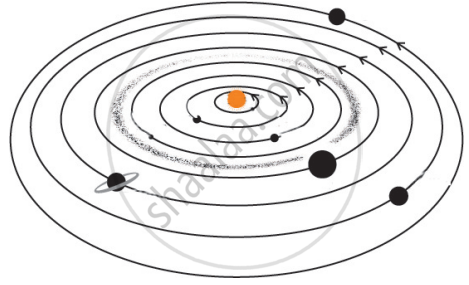
Suppose the distance between the earth and sun becomes half of its present distance. What is likely to happen to life?
Explain with a diagram how you can locate pole star with the help of the constellation Great Bear (Ursa Major).
Solutions for 17: Stars and Solar System
![NCERT Exemplar solutions for Science [English] Class 8 chapter 17 - Stars and Solar System NCERT Exemplar solutions for Science [English] Class 8 chapter 17 - Stars and Solar System - Shaalaa.com](/images/science-english-class-8_6:5f2b1b2038084cf381bfa42c826a928c.jpg)
NCERT Exemplar solutions for Science [English] Class 8 chapter 17 - Stars and Solar System
Shaalaa.com has the CBSE Mathematics Science [English] Class 8 CBSE solutions in a manner that help students grasp basic concepts better and faster. The detailed, step-by-step solutions will help you understand the concepts better and clarify any confusion. NCERT Exemplar solutions for Mathematics Science [English] Class 8 CBSE 17 (Stars and Solar System) include all questions with answers and detailed explanations. This will clear students' doubts about questions and improve their application skills while preparing for board exams.
Further, we at Shaalaa.com provide such solutions so students can prepare for written exams. NCERT Exemplar textbook solutions can be a core help for self-study and provide excellent self-help guidance for students.
Concepts covered in Science [English] Class 8 chapter 17 Stars and Solar System are Moon and Its Phases, Stars and Their Types, Constellation, The Solar System, Other Heavenly Bodies of the Solar System, Other Heavenly Bodies of the Solar System.
Using NCERT Exemplar Science [English] Class 8 solutions Stars and Solar System exercise by students is an easy way to prepare for the exams, as they involve solutions arranged chapter-wise and also page-wise. The questions involved in NCERT Exemplar Solutions are essential questions that can be asked in the final exam. Maximum CBSE Science [English] Class 8 students prefer NCERT Exemplar Textbook Solutions to score more in exams.
Get the free view of Chapter 17, Stars and Solar System Science [English] Class 8 additional questions for Mathematics Science [English] Class 8 CBSE, and you can use Shaalaa.com to keep it handy for your exam preparation.

